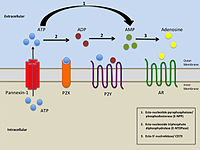
Photo from wikipedia
Pannexins (PANX) were cloned based on their sequence homology to innexins (Inx), invertebrate gap junction proteins. Although there is no sequence homology between PANX and connexins (Cx), these proteins exhibit… Click to show full abstract
Pannexins (PANX) were cloned based on their sequence homology to innexins (Inx), invertebrate gap junction proteins. Although there is no sequence homology between PANX and connexins (Cx), these proteins exhibit similar configurations. The PANX family has three members, PANX1, PANX2 and PANX3. Among them, PANX1 has been the most extensively studied. The PANX1 channels are activated by many factors, including high extracellular K+ ([K+]e), high intracellular Ca2+ ([Ca2+]i), Src family kinase (SFK)-mediated phosphorylation, caspase cleavage and mechanical stimuli. However, the mechanisms mediating this mechanosensitivity of PANX1 remain unknown. Both force-from-lipids and force-from-filaments models are proposed to explain the gating mechanisms of PANX1 channel mechanosensitivity. Finally, both the physiological and pathological roles of mechanosensitive PANX1 are discussed.
Journal Title: International Journal of Molecular Sciences
Year Published: 2022
Link to full text (if available)
Share on Social Media: Sign Up to like & get
recommendations!